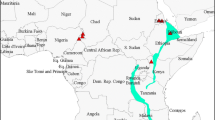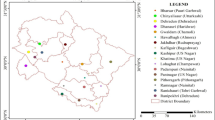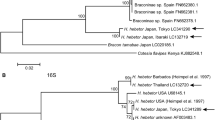Abstract
Pink stem borer, Sesamia inferens (Walker, 1856) (Lepidoptera: Noctuidae) is reported to infest many graminaceous crops and cause significant losses. S. inferens cause damage by killing the central shoot and producing a characteristic symptom called “dead heart”. Since graminaceous crops are an important source of food for humans and their livestock, impetus should be given on designing efficient management strategies against pink stem borer. The study of genetic variability of pest populations enables to interpret the ecological investigations correctly and also helps to comprehend the dissimilar response of pest to management tactics. The present study was undertaken to evaluate the diversity in S. inferens populations using mitochondrial cytochrome oxidase subunit I sequences from India, Pakistan, China and Indonesia. Analysis revealed a very low nucleotide diversity in Indian populations (π = 0.00981), as compared to a high nucleotide diversity in the sequences outside India (π = 0.4989). The phylogenetic analysis also did not show any clustering among populations within India and Pakistan. However, the nearest neighbour for the Indian and Pakistan population is a sequence from Indonesia followed by China indicating possible ancestral background. This is the maiden attempt to assess the molecular diversity of Indian populations in comparison to populations from other Asian countries.


Similar content being viewed by others
References
Armstrong KF, Ball SL (2005) DNA barcodes for biosecurity: invasive species identification. Philos Trans R Soc Lond B Biol Sci 360:1813–1823
Aseefa Y, Mitchell A, Conlong DE (2006) Phylogeography of Eldana saccharina Walker (Lepidoptera: Pyralidae). Ann Soc Entomol Fr 42:331–337
Ashfaq M, Akhtar S, Rafi MA, Mansoor S, Hebert PD (2017) Mapping global biodiversity connections with DNA barcodes: Lepidoptera of Pakistan. PLoS ONE 12(3):e0174749
Atwal AS, Dhaliwal GS (1997) Agricultural Pests of South Asia and their Management. Kalyani Publishers, New Delhi, pp 179–200
Avise JC (2000) Phylogeography. The history and formation of species. Harvard University Press, Cambridge, p 466
Baladhiya HC, Sisodiya DB, Pathan NP (2018) A review on pink stem borer, Walker: a threat to cereals. J Entomol Zool 6(3):1235–1239
Braithwaite K, Chandler K, Sallam N (2016) Barcoding: a tool to assist the industry to manage insect incursions. Proc Conf Aust Soc Sugar Cane Technol 38:Ag11
Chatterji SM, Young WR, Sharma GC, Sayi, IV, Chahal BS, Khare BP, Rathore YS, Panwar VPS, Siddiqui KH (1969) Estimation of loss in yield of maize due to insect pests with special reference to borers (No. REP-10353. CIMMYT)
Choudhary AK, Shrivastava SK (2007) Incidence of Sesamia inferens Walk in sugarcane as internode borer in sugarcane at Hoshangabad, India. Int J Agric Sci 3:320–321
Edgar RC (2004) MUSCLE: a multiple sequence alignment method with reduced time and space complexity. BMC Bioinform 5(1):113
Excoffier L, Lischer HE (2010) Arlequin suite ver 3.5: a new series of programs to perform population genetics analyses under Linux and Windows. Mol Ecol Resour 10(3):564–567
Folmer O, Black M, Hoeh W, Lutz R, Vrijenhoek R (1994) DNA primers for amplification of mitochondrial cytochrome c oxidase subunit I from diverse metazoan invertebrates. Mol Mar Biol Bitechnol 3:294–299
Fu YX (1997) Statistical tests of neutrality of mutations against population growth, hitchhiking and background selection. Genetics 147(2):915–925
Fu YX, Li WH (1993) Statistical tests of neutrality of mutations. Genetics 133(3):693–709
Garg DK (1988) Host range and overwintering of rice pink stem borer (PSB) in a hilly region of India. Int Ric Res Newslett 13(2):23–24
Goftishu M, Assefa Y, Fininsa C, Niba A, Capdevielle-Dulac C, Le Ru BP (2016) Phylogeography of Sesamia cretica Lederer (Lepidoptera: Noctuidae). Phytoparasitica 44(5):641–650
Goftishu M, Assefa Y, Niba A, Fininsa C, Nyamukondiwa C, Capdevielle-Dulac C, Le Ru BP (2019) Phylogeography and population structure of the mediterranean corn borer, Sesamia nonagrioides (Lepidoptera: Noctuidae), across its geographic range. J Econ Entomol 112(1):396–406
Grant WA, Bowen BW (1989) Shallow population histories in deep evolutionary lineages of marine fishes: insights from sardines and anchovies and lessons for conservation. J Hered 89(5):415–426
Hafiz MT, Samreen A (2016) Services of DNA barcoding in different fields. Mitochondrial DNA A DNA Mapp Seq Anal 27:4463–4474
Hall TA (1999) BioEdit: A user-friendly biological sequence alignment editor and analysis program for windows 95/98/NT. Nucleic Acids Symp Ser 41:95–98
Harpending HC, Batzer MA, Gurven M, Jorde LB, Rogers AR, Sherry ST (1998) Genetic traces of ancient demography. Proc Natl Acad Sci USA 95:1691–1697
Hebert PDN, Cywiniska A, Lball SL, Dewaard JR (2003) Biological identifications through DNA barcodes. Proc Royal Soc B 270:313–322
Jaipal S, Malik RK, Yadav A, Gupta R (2005) IPM issues in zero-tillage system in rice-wheat cropping sequence, vol 8, Technical Bulletin, CCS Haryana Agricultural University, Hisar, India, p 5
Kruse JJ, Sperling FA (2001) Molecular phylogeny within and between species of the Archips argyrospila complex (Lepidoptera: Tortricidae). Ann Entomol Soc Am 94:166–173
Kumar S, Stecher G, Tamura K (2016) MEGA7: molecular evolutionary genetics analysis version 7.0 for bigger datasets. Mol Biol Evol 33(7):1870–1874
Librado P, Rozas J (2009) DnaSP v5: a software for comprehensive analysis of DNA polymorphism data. Bioinformatics 25(11):1451–1452
Lunt DH, Zhang DX, Szymura JM, Hewltt OM (1996) The insect cytochrome oxidase I gene: evolutionary patterns and conserved primers for phylogenetic studies. Insect Mol Biol 5(3):153–165
Medina RF, Armstrong SJ, Harrison K (2017) Genetic population structure of sugarcane aphid, Melanaphis sacchari, in sorghum, sugarcane, and Johnson grass in the continental USA. Entomol Exp Appl 162(3):358–365
Nagarkatti S, Nair KR (1973) The influence of wild and cultivated Gramineae and Cyperaceae on populations of sugarcane borers and their parasites in North India. Entomophaga 18(4):419–430
Navajas M, Gutierrez J, Lagnel J, Boursot P (1996) Mitochondrial cytochrome oxidase I in tetranychid mites: a comparison between molecular phylogeny and changes of morphological and life history traits. Bull Entomol Res 86(4):407–417
Nieukerken EJ, Doorenweerd C, Stokvis FR, Groenenberg DS (2012) DNA barcoding of the leaf-mining moth subgenus Ectoedemia s. str. (Lepidoptera: Nepticulidae) with COI and EF1-α: two are better than one in recognising cryptic species. Contrib Zool 81(1):1–24
Roderick GK (2004) Tracing the origin of pests and natural enemies: genetic and statistical approaches. In: Lester EE, Sforza R, Mateille T (eds) Genetics, evolution and biological control. CABI, Cambridge, pp 97–112
Rogers AR, Harpending H (1992) Population growth makes waves in the distribution of pairwise genetic differences. Mol Biol Evol 9(3):552–569
Shashank PR, Chakravarthy AK, Raju BR, Bhanu KR (2014) DNA barcoding reveals the occurrence of cryptic species in host-associated population of Conogethes punctiferalis (Lepidoptera: Crambidae). Appl Entomol Zool 49(2):283–295
Shashank PR, Twinkle S, Chandrashehar K, Meshram NM, Suroshe SS, Bajracharya ASR (2018) Genetic homogeneity in South American tomato pinworm, Tuta absoluta: a new invasive pest to oriental region. 3 Biotech 8:350
Siddiqui KH, Marwaha KK (1993) The vistas of maize Entomology in India. Kalyani Publishers, Ludhiana, p 184
Singh VS (1986) Management of Insect and Mite Pests. In: Tandon JP, Sethi AP (eds) Twenty years of coordinated wheat research 1961–1986. ICAR, India, pp 158–188
Singh B, Kular JS (2015) Influence of abiotic factors on population dynamics of pink stem borer (Sesamia inferens Walker) in rice-wheat cropping system of India. J Wheat Res 7(2):23–28
Slatkin M, Hudson RR (1991) Pairwise comparisons of mitochondrial DNA sequences in stable and exponentially growing populations. Genetics 129(2):555–562
Sun JZ, Zhang JX, Shen XS (1993) The flight capabilities of rice stem borer moths Tryporyza incertulas, Chilo suppressalis and Sesamia inferens. Acta Entomol Sin 36(3):315–322
Tajima F (1989) Statistical method for testing the neutral mutation hypothesis by DNA polymorphism. Genetics 123(3):585–595
Tamura K (1992) Estimation of the number of nucleotide substitutions when there are strong transition-transversion and G+ C-content biases. Mol Biol Evol 9(4):678–687
Tang XT, Jing XU, Lu MX, Du YZ (2019) No evidence for an effect of Wolbachia on mtDNA variation and evolution in natural populations of Sesamia inferens (Lepidoptera: Noctuidae). J Integr Agric 18(5):1050–1063
Tian JC, Chen Y, Li ZL, Li K, Chen M, Peng YF, Hu C, Shelton AM, Ye GY (2012) Transgenic Cry1Ab rice does not impact ecological fitness and predation of a generalist spider. PLoS ONE 7(4):e35164
Valade R, Kenis M, Hernandez-lopez A, Augustin S, Mari Mena N, Magnoux E, Rougerie R, Lakatos F, Roques A, Lopez-Vaamonde C (2009) Mitochondrial and microsatellite DNA markers reveal a Balkan origin for the highly invasive horse-chestnut leaf miner Cameraria ohridella (Lepidoptera, Gracillariidae). Mol Ecol 18:3458–3470
Vialatte A, Dedryver CA, Simon JC, Galman M, Plantegenest M (2005) Limited genetic exchanges between populations of an insect pest living on uncultivated and related cultivated host plants. Proc Royal Soc B 272:1075–1082
Williams JR (1953) The larvae and pupae of some important Lepidoptera. Bull Entomol Res 43(4):691–701
Wilson J, Landry JF, Janzen D, Hallwachs W, Nazari V, Hajibabaei M, Hebert P (2010) Identity of the ailanthus webworm moth (Lepidoptera, Yponomeutidae), a complex of two species: evidence from DNA barcoding, morphology and ecology. Zookeys 46:41
Yudi L, Xingkui A, Maolin H (2014) Rapid microsatellite marker isolation for the Pink Stem Borer, Sesamia inferens (Lepidopetera: Noctuidae), through 454 GS-FLX Titanium pyrosequencing of enriched DNA libraries and cross amplification in related taxa. Appl entomol zool 49(4):613–617
Zardoya R, Meyer A (1996) Phylogenetic performance of mitochondrial protein-coding genes in resolving relationships among vertebrates. Mol Biol Evol 13(7):933–942
Acknowledgements
We are grateful to Dr. Ashok Kumar Singh, Director, Indian Agricultural Research Institute, Pusa Campus, New Delhi for extending financial and administrative support. The first author acknowledges the Indian Council of Agricultural Research, New Delhi for providing Junior Research Fellowship to conduct present research.
Author information
Authors and Affiliations
Contributions
AD performed DNA extraction and sequencing. AD and SPR performed the molecular analysis. MJ, CMK, SMC and JJ collected the larval samples from different parts of India. SPR and NMM conceptualization and manuscript preparation. MC and NS contributed to data analysis. SS and JJ helped in data Analysis and manuscript preparation. Supervision: SPR. Funding acquisition: SPR and NMM. All authors read, reviewed and approved the manuscript.
Corresponding author
Ethics declarations
Conflict of interest
The authors declare that they have no conflict of interest in the publication.
Supplementary Information
Below is the link to the electronic supplementary material.
Rights and permissions
About this article
Cite this article
Dey, A., Shashank, P.R., Meshram, N.M. et al. Molecular diversity of Sesamia inferens (Walker, 1856) (Lepidoptera: Noctuidae) from India. 3 Biotech 11, 134 (2021). https://doi.org/10.1007/s13205-021-02678-y
Received:
Accepted:
Published:
DOI: https://doi.org/10.1007/s13205-021-02678-y




